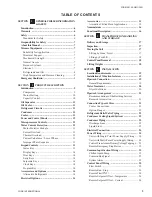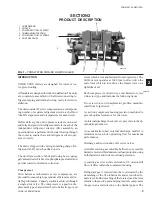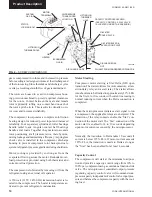
FORM 201.25-NM1 (302)
11
YORK INTERNATIONAL
The automatic spring return of the capacity control valve
to the minimum load position will ensure compressor
starting at minimum motor load.
OIL SEPARATOR
Each circuit has a high efficiency, augmented gas im-
pingement type oil separator to maximize oil extrac-
tion without fragile media to break down.
The oil separator, is mounted in the discharge line of
the compressor. The high pressure discharge gas is
forced around a 90 degree bend. Oil is forced to the
outside of the separator through centrifugal action and
captured on wire mesh where it drains to the bottom of
the oil separator and into the compressor.
The oil drains back into the compressor through a re-
placeable 0.5-3.0 micron oil filter, and oil supply sole-
noid, is at high pressure. This high pressure “oil injec-
tion” forces the oil into the compressor where it is grav-
ity fed to the rotors and bearings for lubrication.
After lubricating the rotor and bearings, it is injected
through orifices on a closed thread near the suction end
of the rotors. The oil is automatically injected because
of the pressure difference between the discharge pres-
sure and the reduced pressure at the suction end of the
rotors. This lubricates the rotors as well as provides an
oil seal against leakage around the rotors to assure re-
frigerant compression (volumetric efficiency).
The oil also provides cooling by transferring much of
the heat of compression from the gas to the oil keeping
discharge temperatures down and reducing the chance
for oil breakdown.
Oil injected into the rotor cage flows into the rotors at
a point about 1.2 x suction. This assures that a required
minimum differential of at least 26 psi (1.8 bar) exists
between discharge and 1.2 x suction, to force oil into
rotor case, a minimum of 9 psi (0.6 bar) is all that is
required to assure protection of the compressor. Oil
pressure is measured as the difference between dis-
charge pressure and the pressure of the oil entering the
rotor case.
Maximum working pressure of the oil separator is 31
bar (450 psi). The oil level should be above the mid-
point of the “lower” oil sight glass when the compres-
sor is running. The oil level should never be above the
top of the “upper” sight glass.
Oil temperature control is provided through liquid injec-
tion activated by the microprocessor, utilizing a tem-
perature sensor, and a solenoid valve.
OIL COOLER
Compressor oil cooling is provided by refrigerant liq-
uid, which is injected into the rotor suction when the
temperature setpoint has been exceeded.
REFRIGERANT CIRCUITS
Each refrigerant circuit uses copper refrigerant pipe
formed on computer controlled bending machines to
reduce the number of brazed joints resulting in a reli-
able and leak resistant system.
Liquid line components include: a manual shut-off
valve with charging port, a high absorption removable
core filter-drier, a solenoid valve, a sight glass with
moisture indicator, and a thermostatic expansion valve.
Suction lines are covered with closed-cell insulation.
CONDENSER
The condenser can be either a field supplied YORK
VCB/Remote Air-cooled condenser or an evaporative
condenser.
COOLER
The 4 pass dual circuit shell and tube type direct expan-
sion (DX) evaporator has chilled liquid circulating across
the tubes from one end to the other. The design working
pressures of the cooler are 150 psi (10 bar) on the wa-
terside (shell) and 300 psi (20 bar) on the refrigerant side
(tubes) which is protected by pressure relief valve(s).
The water baffles are fabricated from galvanized steel
to resist corrosion. Removable heads are provided for
access to internally enhanced, seamless, copper tubes.
Water vent and drain connections are included. The
cooler is insulated with flexible closed-cell foam.
The water nozzles are provided with grooves for
victualic couplings and should be insulated by the con-
tractor after pipe installation.
2












































